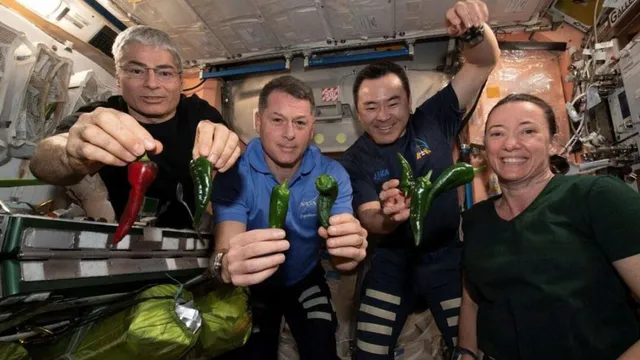- By Supratik Das
- Tue, 08 Apr 2025 07:06 PM (IST)
- Source:JND
When you hear about space travel, you may have visions of being around zero gravity, looking at the planet Earth, and snacking on your favourite food. Few will be doubts in your mind that the astronauts have sabzi wrapped in roti in space or vacuum-packed biryani. No, astronauts living on the International Space Station (ISS) stick to one of the most precisely controlled diets globally. At NASA, food is not selected based on taste alone; it has to be healthy, safe, and convenient in a microgravity environment.
Based on NASA's regulations and food development practices, here are 10 unexpected things astronauts cannot bring to space and the interesting reasons why.
Bread: Crumbs that can kill
Roti, bread, or buns—typical in Indian households—are eschewed in space. Bread forms crumbs that go floating around in zero gravity and can clog air filters, infect equipment, or present inhalation hazards. NASA substitutes tortillas for bread, which are less likely to crumble, leave no crumbs behind, and have a longer shelf life when vacuum-sealed. Based on NASA's guidelines, crumbly food is shunned since free-floating particles may harm hardware or present safety issues within spacecraft.
Salt & pepper: No sprinkle, no gravity
Salt and masalas are an indispensable part of an average Indian meal. However, in space, granular spices drift away. In place of salt and pepper, NASA provides liquid salt and pepper so that it is mess-free and safe. Condiments tend to be suspended in oil or water for controlled use when there is zero gravity.
Carbonated beverages: Fizz becomes bloat
Sodas such as Coca-Cola or Thumbs Up act quite differently in space. The gas does not segregate from the liquid, leading to bloating and discomfort. This phenomenon, referred to as "wet burping," is one of the reasons why carbonated beverages are prohibited on spacecraft.
Fresh milk: A spoilsport in zero-G
A cup of fresh milk a common item in most Indian homes—is taboo in space. It goes bad quickly without the cold. Instead, astronauts consume powdered or ultra-high-temperature pasteurized milk, reconstituted with purified water.
Alcohol: A strict no from NASA
NASA has a total prohibition against alcohol in space. It can degrade performance, interfere with water recycling systems, and be dangerous in emergencies. No toasts are permitted on the ISS, unlike some early Soviet flights.
Leafy greens: Lightweight at high risk
Spinach, lettuce, or methi may seem harmless, but their delicate nature and tendency to wilt make them unsuitable for space. However, experiments with space-grown lettuce have shown promise for future missions. However, NASA is optimistic about future space farming. Astronauts have successfully grown red romaine lettuce in microgravity.
Ice cream: A melting mess
Ordinary ice cream melts and becomes gooey in space and is a hygiene problem. Freeze-dried "astronaut ice cream" exists on Earth as a novelty, but it's not used on a regular basis in space. On occasion, NASA includes frozen goodies on resupply missions to astronauts as morale builders.
Strong-smelling foods: Odour overload
Fish curry or pickles might be a favorite on Earth, but in an enclosed spaceship, odours persist because of inadequate air circulation. Pungent odours could disrupt crew comfort and influence the flavor of other food, so NASA avoids putting smelly foods on the menu.
Fresh fruits: A rotten deal
Bananas, apples, or mangoes do not survive for long in space. Fresh fruits rot rapidly and may emit ethylene gas, accelerating the breakdown of other food. Although a rare indulgence, most fruit on the ISS is freeze-dried to preserve quality without rotting.
Soft cheese: Spoils quickly, smells bad
India's paneer may be soft, but at least it is fresh. Soft cheeses do, however, spoil quickly and emit terrible odours. In an air-tight environment, this is both a health and morale concern. Only hard, processed cheeses with long shelf life pass the cut.
Why do these restrictions matter?
NASA Food Systems plan meals in space years ahead of time, with each product going through processing techniques such as freeze-drying, dehydration, or thermostabilisation, followed by vacuum packing, strict nutritional analysis to last 6 months to 2.5 years on the shelf, and sensory tests to have taste and texture highly rated. Astronauts need three thousand to three thousand eight hundred calories per day, with a diet high in calcium and vitamin D to prevent microgravity-induced loss of bone. At the same time, India's space agency ISRO is preparing for its crewed mission, Gaganyaan, by developing space-friendly versions of well-known Indian foods like upma, poha, and chicken curry, freeze-dried and vacuum-packed for consumption in space.

